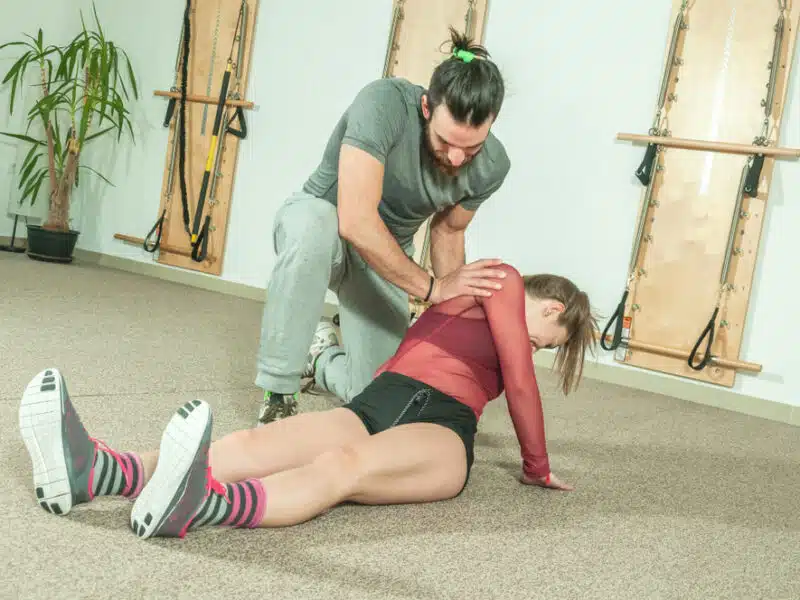Post-Workout Massages: Discover the Power of Blissful Recovery and Unlock 11 Life-Changing Benefits!

Enhance Your Recovery and Maximize Results with Post-Workout Massages
What is Massage 04th Jul, 2023
Fitness fanatics and gym goers! If you’ve ever felt the gratifying burn of a hard workout, you know how crucial muscle rehabilitation is. What’s more, guess what? We have some exciting news for you!

We’re delving into the realm of post-workout massages and how they might help you recover faster. Prepare to be surprised by the delightful advantages that await you after those strenuous sweat workouts. We’ll be revealing the remarkable ways that post-workout massages may speed up your recuperation.
Say goodbye to muscular aches and welcome a renewed sensation of relaxation and regeneration. Your muscles will appreciate you, and you’ll be well on your way to reaching new fitness heights.
The 11 Benefits of Post-Workout Massages
Numerous advantages of post-workout massages can significantly improve your post-workout recovery and general fitness experience. Following are some major advantages of massages after exercise:
1. Muscle Recovery
Muscle stiffness and exhaustion are frequent after strenuous exercise. A post-workout massage reduces inflammation and speeds up cell healing, which helps to lessen muscular aches and weariness.
2. Improved Blood Circulation
Massage facilitates the supply of nutrients and oxygen required for tissue regeneration by increasing blood circulation to the muscles. Additionally, it aids in the removal of metabolic waste products, lowering inflammation and promoting muscle regeneration.
3. Increased Serotonin Levels
Post-workout massages can significantly increase serotonin levels, as well as noradrenaline and dopamine. These molecules have an important role in mood enhancement, relaxation, and stress and anxiety reduction.
4. Reduced Inflammation
Massage can help decrease inflammation, which is a typical side effect of exercise-induced tissue damage. It reduces edema and aids healing by enhancing blood flow and lymphatic drainage.
5. Pain Relief
Massaging stiff and strained muscles after a workout can help relieve pain and discomfort. It relieves muscular tension, promotes relaxation, and may even target specific regions in need of special attention.
6. Improved Posture
Regular post-workout massages help mitigate the negative consequences of prolonged sitting or bad posture. Massages enhance alignment and posture by loosening and relaxing muscles, which results in a healthier and more comfortable body position.
7. Enhanced Flexibility and Range of Motion
Massage therapy helps to improve flexibility and range of motion by targeting and releasing muscular tension. This is especially useful for athletes and those who need a wide range of motion in their activities.
8. Faster Recovery Time
Massages help to remove lactic acid from the muscles, which reduces muscular discomfort and stiffness. This speeds up the recuperation process, allowing you to return to your exercises more quickly.
9. Mood and Energy Boost
Massage causes the release of endorphins, which are the body’s natural mood-enhancing substances. This can help you feel better, have more energy, and avoid post-workout weariness.
10. Stress Reduction and Relaxation
A post-workout massage provides time to rest and decompress. Massage’s relaxing effects aid to relieve stress, promote relaxation, and create a sense of well-being.
11. Individualized Treatment
Each massage session may be customized to meet your individual requirements and concerns. Communicating your post-workout recovery goals with your massage therapist might help them adapt the massage to optimize its effects.
Incorporating a post-workout massage into your routine can optimize your recovery, enhance your performance, and contribute to your overall physical and mental well-being. It’s important to consult with a professional massage therapist to ensure that the massage techniques used are suitable for your individual needs and fitness level.
Reduced Pain and Inflammation in the Muscles
When it comes to reducing inflammation and soothing muscle soreness, post-workout massages are the ultimate game-changer.
One of the key benefits of post-workout massages is their ability to increase blood flow to the muscles. As the therapist’s skilled hands glide over your body, they stimulate circulation, setting off a chain reaction of positive effects. This surge of blood flow brings with it a host of benefits that aid in reducing inflammation and promoting faster healing.

By increasing blood flow, massages help to remove toxins that accumulate in the muscles during intense exercise. These toxins, such as lactic acid and other metabolic waste products, can contribute to inflammation and muscle soreness. As the blood flow improves, these unwanted substances are efficiently carried away, leaving your muscles feeling refreshed and revitalized.
But it goes further than that. Your muscles receive a tremendous payload of nutrients and oxygen thanks to the enhanced blood flow. These fundamental components act as superhuman saviors, swooping in to combat inflammation and encourage healing.
While oxygen powers the cellular processes that facilitate healing, nutrients supply the building blocks required for tissue restoration. Together, they provide the ideal conditions for your muscles to recover and get stronger.
Increase in Mood and Energy
The benefits of post-workout massages for improving mood and energy levels are discussed in more detail below.
- Massage therapy stimulates the release of endorphins, which are natural chemicals in the body known for their mood-enhancing properties.
- Endorphins create a sense of euphoria and contribute to an overall positive mood.
- The increased release of endorphins during a massage can counteract feelings of stress, anxiety, and fatigue that may follow a tough workout.
- By boosting mood, post-workout massages can have a positive impact on mental well-being, promoting feelings of relaxation, contentment, and overall happiness.
- Endorphins act as a natural energy booster, helping to combat post-workout fatigue and promote feelings of vitality and alertness.
- The surge of endorphins from a massage can help alleviate mental and physical exhaustion, providing a rejuvenating effect.
- Increased energy levels after a post-workout massage can lead to improved motivation and focus, making it easier to tackle daily tasks or engage in further physical activity.
- Regular post-workout massages can have a cumulative effect on mood and energy levels, contributing to a general sense of well-being and an improved outlook on life.
- The relaxation and stress-reducing benefits of massage also support better sleep quality, which can further contribute to overall mood and energy levels.
- Post-workout massages provide a time for self-care and relaxation, allowing individuals to disconnect from daily stressors and focus on their well-being.
- The combination of physical and mental rejuvenation from post-workout massages can enhance psychological resilience, helping individuals better cope with the challenges of daily life.
Incorporating post-workout massages into your fitness routine not only supports physical recovery but also promotes mental and emotional well-being.
The release of endorphins during these massages provides a natural mood and energy boost, helping you combat fatigue, reduce stress, and experience an overall sense of bliss. So, treat yourself to a post-workout massage and allow those feel-good chemicals do their thing, filling you with positivity, vigor, and a grin.
Selecting the Right Type of Massage
Choosing the right type of massage is essential to ensure that you reap the maximum benefits for your specific goals and concerns. Whether you’re seeking muscle recovery after intense exercise or simply looking to unwind and alleviate stress, there’s a massage style tailored just for you.

Sports Massage
One of the key benefits of sports massage is its ability to target areas of the body that have undergone intense physical exertion. Whether you’ve been pushing your limits on the field, the track, or in the gym, sports massage focuses on those specific areas that need attention the most. It’s like a tailored treatment that hones in on the muscles and tissues that have been working the hardest.
By targeting these areas, sports massage works to reduce inflammation, muscle soreness, and stiffness. Intense physical activity can lead to the accumulation of inflammatory markers and metabolic waste products like lactic acid. Sports massage helps to flush out these substances, promoting a faster recovery and minimizing post-workout muscle fatigue. It’s like hitting the reset button on your muscles, allowing them to bounce back more efficiently.
Deep Tissue Massage
Are you dealing with chronic pain or tension in your muscles? If so, deep tissue massage could be the answer to finding relief and restoring balance to your body. Known for its ability to target deeper layers of muscle tissue and connective fascia, deep tissue massage is a therapeutic technique that goes beyond the surface, providing lasting benefits.
Deep tissue massage focuses on reaching those deeper layers where tension and knots may reside. It involves applying firm pressure and slow strokes to target specific areas of discomfort. By accessing these deeper layers, deep tissue massage aims to release muscle adhesions and break up tight knots that may be causing pain and restricting movement.
While deep tissue massage may have moments of intensity, the overall goal is to provide you with lasting relief and a sense of well-being. By addressing chronic pain, releasing muscle tension, and promoting relaxation, this technique can bring about significant improvements in your physical and mental state.
Recommended:
What Is Swedish Massage? How Does Deep Tissue Compare?
Swedish Massage
If you’re in need of pure relaxation and a moment of tranquility, Swedish massage is the perfect choice for you. Known for its gentle and flowing strokes, Swedish massage focuses on creating an atmosphere of deep relaxation and overall well-being. While it may not be the primary choice for immediate post-workout recovery, it can be incredibly beneficial later in the recovery process when relaxation and general well-being take center stage.
Swedish massage is designed to promote relaxation and reduce stress. The therapist uses a combination of long, gliding strokes, kneading, and gentle tapping motions to create a rhythmic and soothing experience. These techniques work together to increase circulation, improve lymphatic flow, and enhance the overall relaxation response in the body.
Unlike sports massage or deep tissue massage, Swedish massage is not specifically focused on relieving muscle tension or pain. Instead, it aims to create a sense of calm and tranquility throughout the entire body. The gentle strokes and rhythmic movements help to calm the nervous system, reduce anxiety, and promote a deep state of relaxation. It’s like taking a mini-vacation for your body and mind.
It is critical to evaluate your unique needs, interests, and state of recuperation while selecting the correct style of massage. Sports massage is your best chance for focused muscle repair, inflammation reduction, and mobility enhancement. Deep tissue massage may be an appropriate alternative if you are looking for relief from persistent pain or stress. And if you’re looking for a way to relax and feel better in general, Swedish massage might be a great option.
FAQs
What massage is best after a workout?
A sports massage or deep tissue massage is generally the best type after a workout, as they can help relieve muscle tension and promote recovery.
How long should you wait to get a massage after working out?
Ideally, wait at least 24 hours after a workout before getting a massage to allow your body to initiate natural recovery processes.
Does massage after workout help build muscle?
While massage itself doesn’t build muscle, it can enhance recovery, reduce muscle tension, and improve flexibility, which may support overall muscle growth and performance.
Is it OK to workout before massage?
Yes, it’s generally fine to workout before a massage. However, it’s a good idea to allow some cool-down time between the end of your workout and the start of your massage.
Should I workout before or after massage?
It’s generally recommended to workout before a massage rather than after, as massage can help in recovery and relaxation, which could be disrupted by an intense workout.
The Bottom Line
The 11 benefits of post-workout massages provide a compelling case for incorporating this rejuvenating practice into your fitness routine. From reducing inflammation and muscle soreness to boosting mood and energy levels, these massages offer a holistic approach to recovery.
You may optimize the advantages and unleash the full potential of your body’s healing capacities by choosing the correct style of massage and following professional advice.
So, give yourself the pleasant pleasure of post-workout massages and see how they may alter your entire well-being. Accept the power of touch, nourish your muscles, and take your fitness path to new levels of accomplishment and rejuvenation.
















